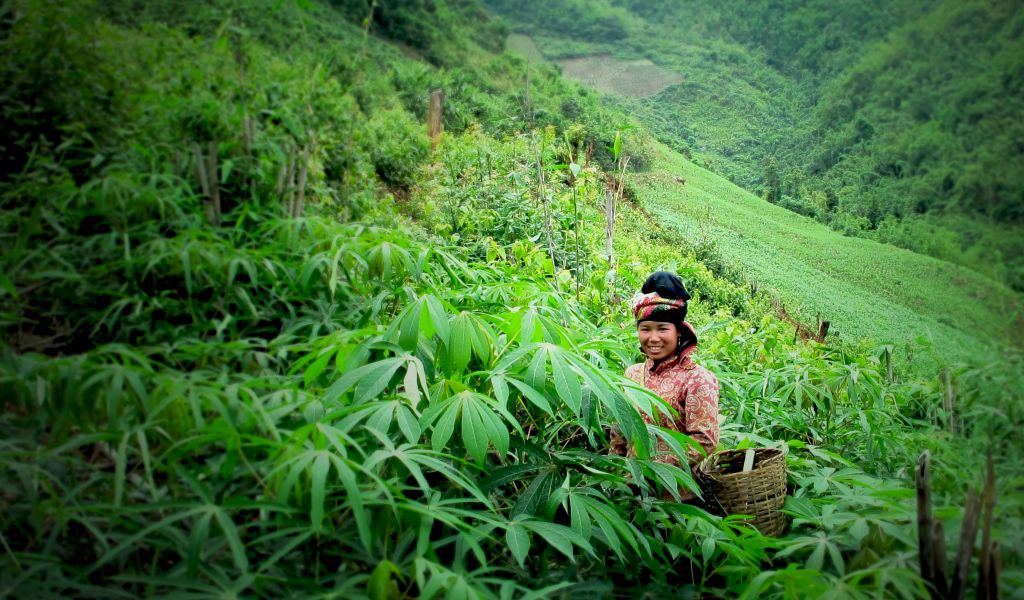Resilient Landscapes for a Healthier Future

What is this woman doing in a field of cassava? What does she have to do with resilient landscapes? And by the way, what is a forest landscape and what is resilience?
This woman is performing her agricultural activities, in this case growing cassava, in the context of a forest landscape. A forest landscape refers to both forests and agriculture in the broader context of the landscape; that is, the heterogeneous mosaic of different land uses (agriculture, forestry, soil protection, water supply and distribution, biodiversity conservation, pasture provision, etc.) across a large area of land or watersheds.
With this definition of forest landscape, our Center, called The Center for People and Forests, advocates that we take the time to involve stakeholders from all affected land-use sectors, including the farmers and local people working on agriculture, forestry, soil protection, water supply and other activities. In so doing, we make sure to apply a participatory decision-making processes to strengthen rural livelihoods and ensure healthier forest landscapes.
So what does a “healthy” forest landscape look like?
Like in virtually every place on the planet, the forests of the Asia Pacific region are facing an uncertain future. Wildfires, large insect outbreaks, and other climate-induced die-offs are changing the complexion of the region’s forest landscapes. Beyond climate change, deforestation and degradation from human activity is also changing the nature of our forest landscapes as economic interests pull on the very thread of what we would call a healthy landscape. This has led to a common notion that we are facing a “forest health crisis.” But what exactly is a “healthy” forest landscape? There is no one scientific definition of forest health; the notion is a human construct imbued with social and cultural meaning. A healthy forest thus depends on who is doing the defining.
Most of us would agree that a healthy forest is one that has living trees. But a healthy forest is also one that has a counter balance of dying and dead trees; it’s a matter of degree. We at the Center also argue that a “healthy” forest landscape is one that includes the flora and fauna that lives within it, including human being. We are part of the ecosystem and need to consider our health as much as the trees. So a healthy forest must include the interaction between people and forest… Hence the name of our Center: The Center for People and Forests.
Last but not least, everyone is talking about climate change and resilient landscapes. What does this word “resilient” mean?
The birth-life-death cycle of a forest landscape span decades, sometimes centuries. In today’s attention-deficit society, sustaining the patient, long-range view of forest landscapes poses an enormous challenge, as does sustaining long-term experience with a particular forest: professional forest managers, local politicians and even farmers change on a frequent basis. However, working against this tide of change is “community forestry,” broadly named initiatives that advance the notion that the long-term relationship communities of place can have with their surrounding forests presents an opportunity to manage forest landscapes thoughtfully for the benefit of both the ecosystem and society.
People, families, and communities that cultivate forest stewardship knowledge and practices over long periods of time can accumulate an appreciation for what a forest needs to be “resilient” – that is, to continually absorb and recover from disturbances without losing its vital components. And it’s not just trees that comprise forests, but also the diversity of plants and animals, water flows to streams and rivers, and opportunities for families to derive a livelihood without destroying the very thing that provides that livelihood.
So that is what we mean when we say building resilient landscapes. The slogan “one forest at a time” refers to the local knowledge of that particular place knowledge and practices that accumulates over long periods of time but helps us understand the complex and inter-twined relationships between people and forests.
The women in the cassava field may represent just one of our local stakeholders, but she is actively looking for a voice to determine how the forest landscape is managed.
We owe it to her to listen and work on designing better governance and monitoring systems that will maintain the resiliency that allows her to continue her livelihood from the land.

